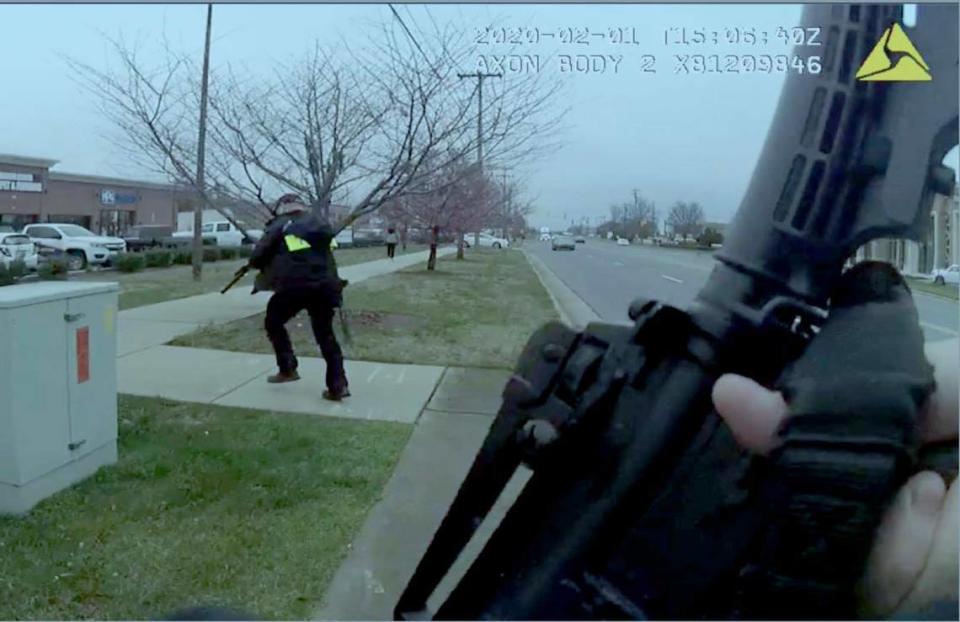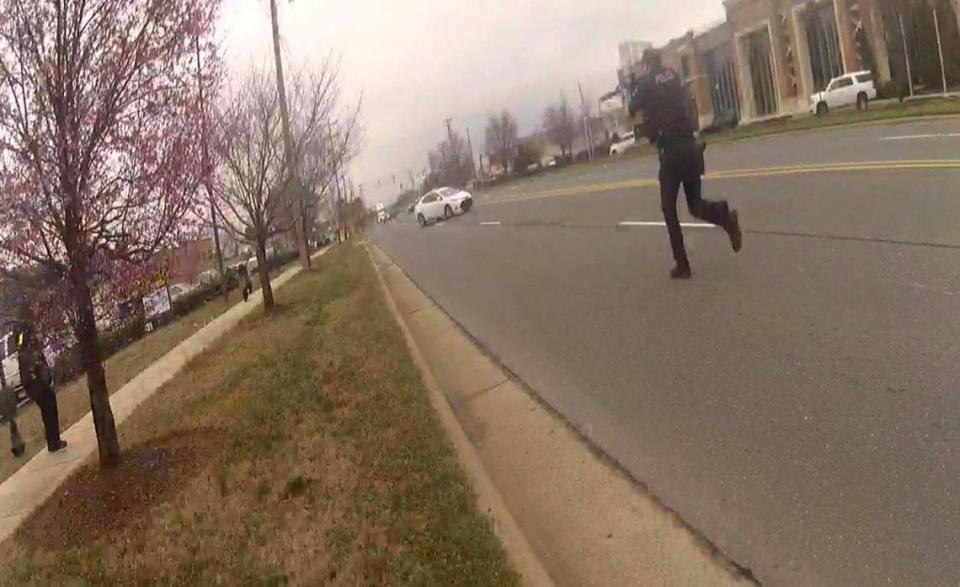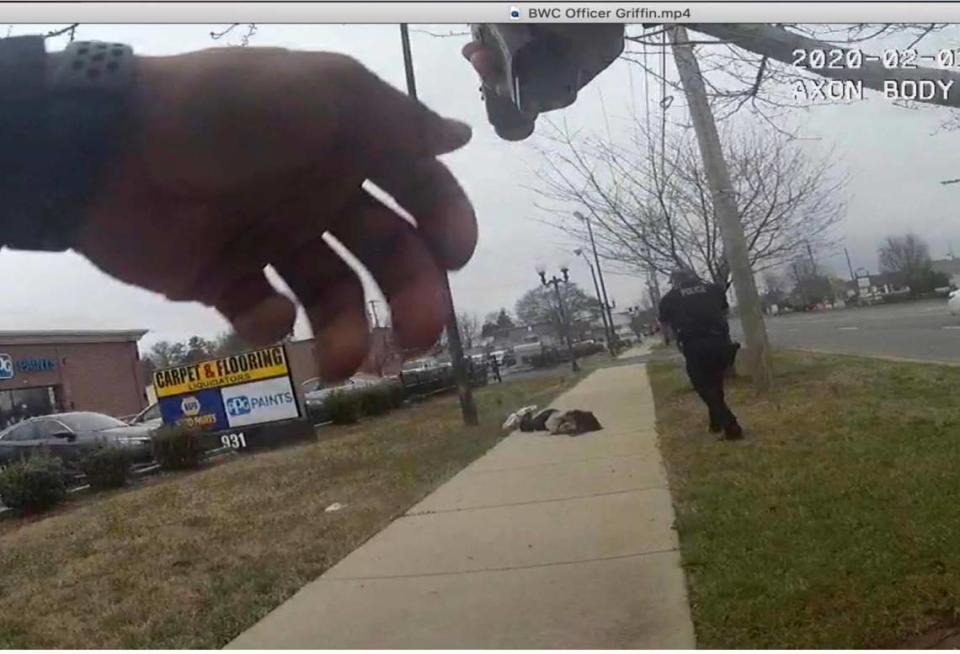Pineville police shot man who put down gun and ‘did what I was told to do,’ lawsuit says
After shooting Timothy Caraway multiple times last year, Pineville police rushed to the bleeding and temporarily paralyzed suspect and ordered him to raise his hands.
Caraway, according to bodycam video from one of the officers, told them he couldn’t comply because he couldn’t feel anything. Then he repeatedly asked the officers the same question: Why was he shot?
“I just did what I was told to do. Y’all said to drop it,” Caraway said, crying out in pain. “I went on the ground. Why did y’all shoot me? ... Please don’t let me die.”
Caraway, then 23, survived. When he was released from the hospital, Pineville police charged him with eight crimes, including four counts of assault on a police officer for allegedly pointing his handgun at the four officers who confronted him on Feb. 1, 2020.
Those charges were quickly dropped by the Mecklenburg County District Attorney’s Office for what a prosecutor described in a court filing as insufficient evidence, particularly concerning Caraway’s intent. By that time, Caraway had spent a month in custody.
Now, Caraway’s new lawsuit, filed Thursday, flips the narrative of the shooting with a series of explosive allegations against Pineville police:
That two officers fired on Caraway while he was on one knee, following orders to lay down the weapon that he’d been carrying in the right pocket of his coat. That police kept shooting after the wounded Caraway lay helpless on the sidewalk.
The officers then conspired to justify what they had done by fabricating evidence to put Caraway in jail, the lawsuit alleges.
Caraway’s attorney, Micheal Littlejohn of Charlotte, said his client found himself trapped in a “deadly game of ‘Simon Says’” in which the armed police officers rushed up behind him, gave him multiple and conflicting commands, then opened fire within seconds and kept shooting until one of their colleagues shouted at them to stop.
The ranking officer on the scene that day, Sgt. Nicholas French, later told state investigators that he had not fired his weapon because Caraway never raised or extended his handgun in a threatening way, the lawsuit says. A witness to the shooting, according to the complaint, also said Caraway did nothing to trigger the police use of deadly force.
“The excessiveness of the police force is unspeakable,” Littlejohn told the Observer on Friday. “My client did not commit a crime that day. Period. And this is what happened.”
Caraway’s lawsuit, which was filed in Mecklenburg County, names the Town of Pineville along with police officers Adam Roberts, Jamon Griffin, Leslie Gladden and French.
Roberts and Griffin fired the shots. Griffin, a former Hickory police officer who had been with the Pineville department for less than a month at the time of the shooting, pulled his trigger nine times, according to the complaint. Roberts fired three times, including the first shot that struck Caraway in the neck and sent him falling face first to the cement, the lawsuit says.
Griffin and Caraway are Black. Gladden, French and Roberts are white.
The complaint accuses the town and the police officers of excessive force, malicious prosecution, fabrication of evidence and false arrest, among other claims.
Pineville Town Manager Ryan Spitzer on Friday referred requests for comment to town attorney Scott MacLatchie, who did not respond to an Observer email.
Police Chief Michael Hudgins did not return an Observer phone call requesting an interview for this story. In March, when police released video of the shooting, Hudgins had confirmed that Caraway initially raised his hands when confronted by his officers, according to WCNC.
The chief also told reporters that it was “plausible” police initially mistook Caraway’s cellphone for a handgun. He said his officers opened fire when Caraway reached into his pockets, where he was actually carrying a weapon.
Drop your weapon
Caraway’s lawsuit joins a list of other active civil complaints against police in which Charlotte-area residents were shot — at least two fatally — under controversial circumstances involving guns.
▪ The widow of Rubin Galindo claims in a 2019 lawsuit that Charlotte-Mecklenburg police used “paramilitary tactics” in fatally shooting her longtime partner two years before. Galindo had called police that night, told them he wanted to turn in his handgun, and was shot coming through the door of his home with his arms raised and the gun in his hand. That case is scheduled for trial in September.
▪ In March 2019, Danquirs Franklin was fatally shot during a standoff with police in the parking lot of a Burger King in west Charlotte as he appeared to be lowering his gun in compliance with orders. Franklin’s mother later sued. A trial is scheduled for November.
The confrontation on North Polk Street in small-town Pineville opened with a phone call.
Right around 10 a.m., a driver called 911 to report that she had seen a Black man with long dreadlocks and wearing a tan jacket pointing a gun as he walked along one of the town’s main drags.
According to the lawsuit, Caraway was walking up Polk that morning to visit his grandmother, unaware that police were now streaming toward him, several loading assault rifles as they approached.
Roberts, according to the complaint, arrived first. The other officers soon followed. Two had either turned off their body-worn cameras or had not activated them, an apparent violation of department policy, the lawsuit claims.
The video from Roberts’ camera shows the officer walking up behind Caraway as other officers flank him. A series of shouted police orders ring out over a few seconds. Caraway briefly comes into view either kneeling on the ground or close to it. What he’s doing with his hands is unclear. Then the shooting starts.
The police stream toward Caraway as he screams in pain, the video shows. As police try to slow Caraway’s bleeding, one of the officers tells the wounded man that he should not have reached for his pockets. Caraway said he was only following police orders.
State and federal law allows police to use deadly force only if they reasonably perceive an imminent threat of death or serious injury to themselves, other officers or bystanders.
Phil Stinson, a professor of criminal justice at Bowling Green State University and a frequent critic of police tactics, watched the video at the Observer’s request and said it is “inconclusive” whether police used excessive force.
In a statement that accompanied the lawsuit, Littlejohn said the Caraway shooting is another example of police deploying excessive violence against Black citizens.
“Black people in this country are acutely aware of the danger police stops pose to Black lives,” he said.
“Mr. Caraway — a victim of excessive force — is trying his best to cope with the incident and continues to receive treatment for the injuries he sustained.”
Caraway suffered gunshot injuries to his shoulder, chest, neck wrist and at least one finger. Littlejohn said his client still has bullet fragments that he will carry for the rest of his life.

 Yahoo Movies
Yahoo Movies 










